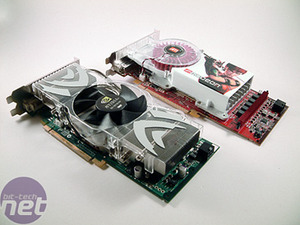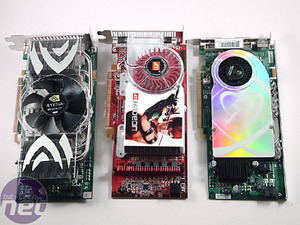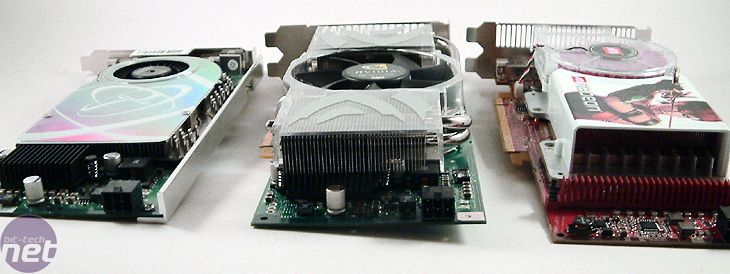
Both the GeForce 7800 GTX 512MB and Radeon X1800XT have dual-slot coolers. You would expect the cooler on the GeForce 7800 GTX 512MB to be heavier than the Radeon X1800XT, as it is much larger (see below, left). However, the cooler on the Radeon X1800XT makes it subjectively heavier than the GeForce 7800 GTX 512MB.



Rather than focusing on reporting the minimum and average frame rates for every configuration, we have decided to move the focus to resolution and settings. Thus, we are displaying our "Best Playable" resolutions and settings in a table that should be easier to understand than our previous format. If you take the logic that the higher the resolution and in game details, the faster the video card, you will not go far wrong.
In situations where we find that two competing video cards run at the same settings, we will bring the frame rates in to the discussion of our gameplay experiences with each particular video card.
Video Cards:
With Catalyst 5.11, ATI has introduced a second Adaptive Anti-Aliasing mode for greater performance. You can see comparison screenshots of the two modes, along with normal Anti-Aliasing here.
We use the following abbreviations on our best-playable settings tables:
Final note:
Unfortunately, our testing was cut short by a hard drive failure. There are no gameplay evaluations for Age of Empires III, City of Villains, and NFS: Underground 2. There are also no apples to apples comparisons. We will be revisiting and updating the remainder of this review when our test system is back up and running.



Gameplay Evaluations - How We Tested:
Please be aware that the way we test our video cards is not a like-for-like comparison, and it is not meant to be. We decided to concentrate on finding the "Best Playable" settings - this means that we're finding the best possible gaming experience delivered on each different configuration. There are no timedemos used in our evaluations - we're focusing on the real-world gaming experience, which is, ultimately what should determine your next video card purchase.Rather than focusing on reporting the minimum and average frame rates for every configuration, we have decided to move the focus to resolution and settings. Thus, we are displaying our "Best Playable" resolutions and settings in a table that should be easier to understand than our previous format. If you take the logic that the higher the resolution and in game details, the faster the video card, you will not go far wrong.
In situations where we find that two competing video cards run at the same settings, we will bring the frame rates in to the discussion of our gameplay experiences with each particular video card.
System Setup
AMD Athlon 64 X2 4800+ (operating at 2400MHz, 12x200MHz); DFI LANParty nF4 SLI-DR (NVIDIA NForce4 SLI); 2 x 1GB Corsair XMS4000 Pro (operating in dual channel at 200MHz with 2.0-3-2-7 1T timings); Western Digital Raptor 74GB, 10000RPM SATA 150 Hard disk drive; OCZ PowerStream 520W Power Supply; Windows XP Professional Service Pack 2; DirectX 9.0c; NVIDIA NForce4 Standalone chipset drivers, version 6.70.Video Cards:
- 1x NVIDIA Reference GeForce 7800 GTX 512MB - operating at its default clock speeds of 550/1700MHz using Forceware version 81.89.
- 1 x ATI Radeon X1800XT 512MB - operating at its default clock speeds of 625/1500MHz using Catalyst 5.11 WHQL with Catalyst Control Center, available here.
- 1 x XFX GeForce 7800 GTX Extreme Gamer Edition 256MB - operating at its default clock speeds of 490/1300MHz using Forceware version 81.89 available from nZone.
- 1 x NVIDIA Reference 7800 GTX 256MB - operating at its default clock speeds of 430/1200MHz using Forceware version 81.89 available from nZone.
With Catalyst 5.11, ATI has introduced a second Adaptive Anti-Aliasing mode for greater performance. You can see comparison screenshots of the two modes, along with normal Anti-Aliasing here.
We use the following abbreviations on our best-playable settings tables:
- QA AA - Quality Adaptive Anti-Aliasing (ATI Radeon X1000 series);
- PA AA - Performance Adaptive Anti-Aliasing (ATI Radeon X1000 series);
- HQ AF - High Quality Anisotropic Filtering (ATI Radeon X1000 series).
- TSS AA - Transparency SuperSampled Anti-Aliasing (NVIDIA GeForce 7 series);
- TMS AA - Transparency MultiSampled Anti-Aliasing (NVIDIA GeForce 7 series);
- HQ Driver - High Quality Driver Settings to remove noticeable texture shimmering in certain titles (NVIDIA);
Final note:
Unfortunately, our testing was cut short by a hard drive failure. There are no gameplay evaluations for Age of Empires III, City of Villains, and NFS: Underground 2. There are also no apples to apples comparisons. We will be revisiting and updating the remainder of this review when our test system is back up and running.

MSI MPG Velox 100R Chassis Review
October 14 2021 | 15:04





Want to comment? Please log in.